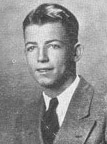|
The 492nd Bombardment Squadron was stationed at Panagar, our second stop in India. This was during the early part of l943 and the beginning of the monsoon season. We had heard much about these storms and now we were experiencing them. Heavy rain could last a few minutes or an hour or so, and continue for months. There was a large lake within our camp area, about a hundred feet wide and maybe a couple of hundred feet long. The rains were slowly filling the lake that provided water for the nearby village. They also brought bullfrogs. We were getting accustomed to the other night noises, jackals barking, peacocks screeching, monkeys chattering and now we had to contend with the croaking of the frogs. The new noise and lack of sleep were the topics of conversation. Some of the men had never heard a bullfrog and were amazed that a small frog could be so loud. As a teenager visiting my old hometown in Arkansas, I had spent many hours with my friend gigging frogs on the mill pond. Now I would try my luck in India hunting frogs. Early one afternoon I was making a spear from a piece of scrap metal and securing it to a cane pole. It was crude, but very effective. Charles Magee, a co-worker and another man came to the bench where I was working. Magee asked, “Brad, do you know this man?” I turned, and what a surprise! My answer was “I certainly do.” It was a Tech buddy, Richard Lyon. We shared a locker in the shop corridor and both lived in northeast Memphis. After a long hug, I asked him, “What in the world are you doing here?” He said, “I am the crew chief on one of the C-46 transport planes that landed at your base. We are refueling and will spend the night. Tomorrow we join the Air Transport Command in northern India and fly supplies into China. Richard had spent some of his life in the country and knew frog gigging, so he joined Magee and me in the sport. I asked the mess sergeant about cooking the frogs if we were successful. He said, “No, we are not allowed to cook any of the local food that has not been approved by our medical officer. I can give you anything you need to cook them outdoors.” Darkness came and so did the frogs. Magee and I brought some of the mechanics’ headlamps from the supply. This had a reflector attached to an elastic headband, with the wires going down the back to a battery pack hooked to the belt. That was the best frog gigging light I ever had. It didn’t take long to spear more than a dozen. Magee and Richard were bringing them to me and I’d dress them, cutting off and skinning the hind legs. We went by the mess hall and picked up an old skillet, flour, salt and oil, then to our shack. I washed, floured and salted them, and a hot fire surrounded by bricks to hold the skillet cooked the legs to a golden brown. No bread, no vegetables, just frog legs and they were delicious. That was the end of our visit with Richard. He went to the transient quarters where the C-46 crews were and spent the night. The six planes left the next morning. I never heard from nor of Richard Lyon after that meeting. Two years later I was in the Cairo, Egypt airport on my way home and talked to a soldier who had been with the Air Transport Command. I asked him about the C-46s. He said they did not fare so well flying the ‘hump’. They were under powered, usually overloaded and an easy target for Japanese fighter planes. I would like to hear from anyone who might have any information on Richard Lyon or his older brother, Eric Lyon (Tech 1937). Mjbcbivet@aol.com
|
